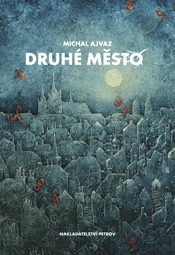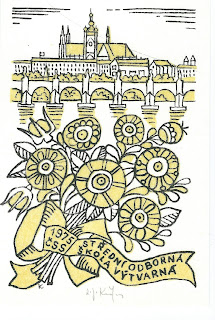Yesterday we celebrated Masopust (Czech Carnival). It was the first time my husband had been at our Czech home for the festival. I am not sure why but he normally has returned to England and left me to celebrate alone.
The Masopusters arrive here on their procession around the villages in the mid-afternoon, after a several hours of dancing and singing. Our neighbours Jitka and Eliska had joined with us to offer the Masopusters food and drink. The table had Czech delicacies of stuffed hard-boiled eggs, pastries, small open sandwiches and strudel, to which we added Scottish shortbread. We could hear the Masopusters approach through the village, stopping at various houses to sing and dance, thus blessing the homes with prosperity for the coming year.
At last they arrived in our little cul de sac. We slotted our donations into the Masopust charity box and were swept into a dance. After the dance and the songs we offered our food and the Masopusters already replete after their travels very nobly ate some of the food and drank some of the cherry brandy. They left inviting us to attend the traditional Masopust ball that evening.
When my husband and I turned up at Horice Na Sumava Cultural Hall things were in full swing. The beer was flowing and everyone was feeling very mellow. We arrived just in time for the highlight of the night. The Masopusters processed into the hall together with an old man dressed up as a priest and two women comperes. The traditional dance resumed, with the Masopusters ending up encircling a man in a costume of multi-coloured rags who personified Masopust. Masopust made some lewd gestures at the dancers and was shot by the others.
He was lifted on to a stretcher and blessed by the priest. A fake funeral ensued - the priest's words causing hilarity in the audience. How we wished we could understand Czech! The stretcher was lifted onto the men's shoulders and led by the priest they processed twice around the hall. All the time the priest was sprinkling "holy" water from a chamber pot using a lavatory brush, making sure we all got a dose of water. The funeral done, the band struck up a Czech song which we recognized as Roll Out the Barrel and the Masopusters took partners from the audience and started to dance.























![By Nelliette (Own work) [CC BY-SA 3.0 (http://creativecommons.org/licenses/by-sa/3.0)], via Wikimedia Commons](https://blogger.googleusercontent.com/img/b/R29vZ2xl/AVvXsEgPgT9sYCS1bye8Q4DUGL4aYBB9cYNCq4hQVw09QbAYRquNYI8LJlFlc9qZXOK1SwadJiK_8EgJ4CP0StHjcd2CLOjRXdx66Bmor6LtfInyNx6Z4R2vtqy_NeOYarVeTQeNhn2Xwn8C8vQ/s320/benes+stamp.jpg)


























![By High Contrast (Own work) [CC BY 3.0 de (http://creativecommons.org/licenses/by/3.0/de/deed.en)], via Wikimedia Commons.](https://upload.wikimedia.org/wikipedia/commons/thumb/7/7d/Bus_in_Prague%2C_near_the_main_train_station.jpg/512px-Bus_in_Prague%2C_near_the_main_train_station.jpg)